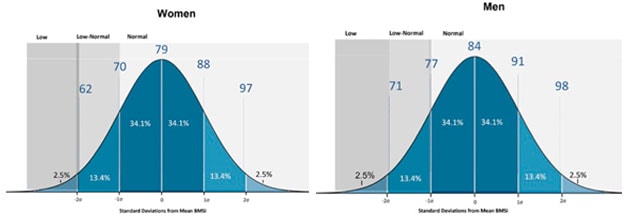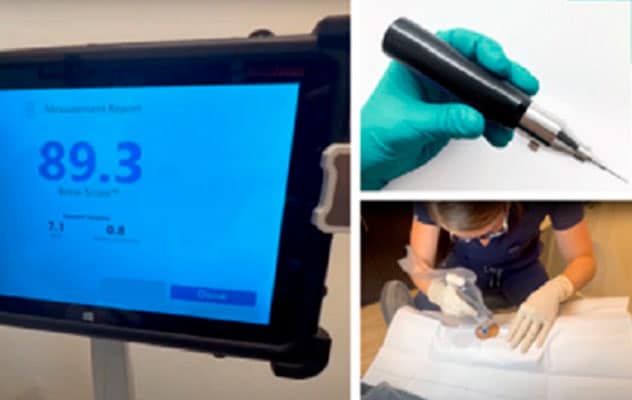April 09, 2024
 骨质材料强度指数
骨质材料强度指数
骨探针的输出结果被称为骨质材料强度指数(BMSi)。上图显示了成年人的参考值,以及平均值正负两个标准差的 BMSi 分隔点。经《钙化组织国际期刊》许可转载。
In its ongoing commitment to advancing medical care, Mayo Clinic continues to innovate in comprehensive bone health management. In tandem with programs such as the Mayo Clinic Healthy Living Program, Mayo Clinic seeks to integrate cutting-edge measurement technologies into bone health diagnosis and monitoring. This approach empowers physicians to conduct accurate bone health assessments and track changes driven by treatment, lifestyle adjustments or disease progression.
The process of diagnosing reduced bone health presents a formidable challenge, as health reflects both bone mass and bone quality. Weakened bones can lead to fragility fractures, causing profound consequences for individuals. Fragility fractures are alarmingly common, affecting 1 in 3 women and 1 in 5 men older than 50 over the course of their lifetimes. Moreover, bone weakening can originate from an array of factors, including aging, genetics, specific medical conditions, medical treatments and even a sedentary lifestyle, which can result in a condition known as disuse osteoporosis. These factors often overlap, rendering the diagnostic process complex for healthcare professionals. Understanding the intricacies of bone health diagnosis and monitoring has fueled Mayo Clinic's embrace of cutting-edge bone measurement technologies.
"Each patient we see is unique, and this tool gives a glimpse into each patient's unique situation."
 使用骨探针
使用骨探针
最终输出的 BMSi(左)、手持式骨探针装置(右上)和在胫骨前端中轴进行的测量过程(右下)。图片由 Active Life Scientific Inc. 提供
The gold standard for assessing bone health is dual-energy x-ray absorptiometry (DXA or DEXA). DXA estimates bone mineral density (BMD) at the hip and spine, which if very low, can increase the risk of fracture. DXA imaging provides a valuable understanding of how much calcium is present in the skeleton. However, DXA alone cannot provide a full representation of bone health. To attain a comprehensive understanding of bone health, Mayo Clinic has deployed a diverse array of advanced measurement methods for its patients. These methods encompass intricate DXA scan analyses, extensive family history surveys and the application of the latest FDA-cleared measurement devices.
An addition to Mayo Clinic's diagnostic toolkit, a new bone probe microscopically measures bone tissue hardness, yielding a result called a bone score. The integration of this device marks a significant milestone, particularly since Mayo Clinic researchers pioneered its use in a clinical study in 2010.
Research using the probe conducted on patients with type 2 diabetes found that these patients, despite often displaying elevated or normal BMD, have deficient bone tissue quality. This finding, published in Calcified Tissue International in 2023, aligns with clinical data indicating that patients with type 2 diabetes have an increased risk of fractures. Collectively, these data demonstrate that bone quality assessed with the probe is an important contributor to understanding skeletal health beyond simply bone mass.
Matthew T. Drake M.D., Ph.D., of Endocrinology, Diabetes Metabolism, and Nutrition at Mayo Clinic in Rochester, Minnesota, explains, "Additional metrics such as the bone score combined with gold standard metrics such as BMD enable us to construct a more nuanced view of a patient's bone health.
"These metrics also provide valuable insights into a patient's response to treatment. Even if BMD remains unaltered, changes in these other metrics can provide critical insights into the effectiveness of therapy. Each patient we see is unique, and this tool gives a glimpse into each patient's unique situation."
Incorporating the probe into a comprehensive diagnostic toolkit was an important next step in enhancing the diagnosis, treatment and care of patients with skeletal disorders. Dr. Drake states, "In cases where patients present with multiple underlying factors affecting their bone health and treatment response, these additional bone health metrics play a pivotal role in assessing fracture risk and selecting the most suitable approach to treatment."
For more information
Rufus-Membere P, et al. Reference intervals for bone impact microindentation in healthy adults: A multi-centre international study. Calcified Tissue International. 2023;112:333.
Refer a patient to Mayo Clinic.